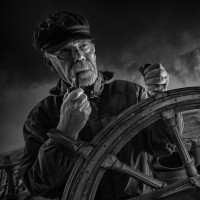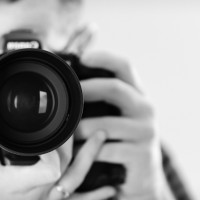by Mel Brackstone
Dicky Beach at Caloundra on the Sunshine Coast of Queensland, Australia, is the only beach named for its shipwreck. The wreck itself is quite small, but clever use of lenses can change that perception.
Getting to know the weather, tides and sunrise times is important. Being near the ocean can be very dangerous, and you must always be aware of the movement of the waves as well as know whether the tide is coming in or going out. The hour before high tide is often the most unreliable. Errant waves can show up without warning, lifting you and your equipment from a spot that was well clear of water only seconds before. Getting to know your location can also make a big difference to your shoot. You can scope out the location beforehand with online maps and programs such as The Photographer’s Ephemeris (TPE), which help you set your bearings with sun positions and times as well as how to best approach the spot you're planning to shoot.
"We wouldn't have made the trip if there had been no chance of clouds in the sky. They can make or break a dawn shoot."
Canon 5D Mark II . Canon 16-35mm f/2.8L . 1/2ss . f/16 . ISO50
This was my first visit to Dicky Beach, and luckily everything fell into place, including the clouds. We wouldn't have made the trip if there had been no chance of clouds in the sky. They can make or break a dawn shoot. Having clouds adds drama to a scene and having dark stormy clouds is even better!My friend and I left Brisbane at around 2:00 a.m. so that we would arrive at the site in time to catch the sunrise. We usually try to be there at least 45 minutes before the sun crests the horizon since there can be some very beautiful predawn light.The wreck looks good at all levels of the tide, but on this particular morning we chose to shoot the site on a rising tide because the water movement through the staves added a good deal of interest. However, this can be dangerous, and much care must be taken because it's easy to forget that you can be swept away if you're not paying attention. The beach slopes quite a bit, and so the water gathers a lot of speed. We arrived around 4:45 a.m. and made our way down to the beach. Luckily the walk from the parking lot is short and quite safe, with only a sand path to be negotiated. As it was a weekday, we were the only people around. Weekends you usually have to fight for space! Since the wreck is not very large, we were able to move around it without too much trouble, taking shots as the water raced in and out. The waves were retreating quite a long way sometimes, and so I'd move in close, but then a huge roller would turn up and I'd have to retreat.
"Getting wet is all part of the job. Keeping the camera dry is the hardest part!"
Being aware of how deep the water can get is very important when shooting at the beach. The weather here is very mild, and so I was only wearing shorts and a light shirt. Getting wet is all part of the job. Keeping the camera dry is the hardest part! Because it's on a tripod, the whole thing can be lifted off the sand when the waves get too high.I moved over to this side of the wreck just after the sun rose, and suddenly I saw the shadows reaching out through the center of the wreck. Setting the tripod into the sand and trying to avoid all the waves, I aimed the lens toward the light, all the time trying to avoid lens flare. Using Lee filters usually exacerbates this, and stacking them makes them even more susceptible. I stacked two Lee neutral density graduated filters, 0.6 and 0.9, with the camera mounted on my tripod in the water. It was shot in RAW format.
"The waves kept on coming, so the tripod was slipping in the moving water and soft sand. Many of the images were not sharp enough to use."
As I was shooting in Aperture Priority (AV) mode, the aperture determined the shutter speed, and I ended up on f/16 in an attempt to slow down the shutter to give me a little motion blur. The waves kept on coming, so the tripod was slipping in the moving water and soft sand. Many of the images were not sharp enough to use. After the sun moved up into the clouds, the shadows disappeared, so I moved back up the beach to try and stay away from the waves.
The image turned out not to need much work. I made a few adjustments to it in Photoshop.
1) First I used the Healing Brush tool to remove some sensor dust spots.
2) I then increased the contrast slightly.
3) Finally, as always, the horizon needed a little tweak to bring it back in line. That meant a slight crop from the original.
I'm married and in my late 50s, and I am the mother of two grown-up children. My obsession with photography began around 2003, and in 2004 I bought my first digital camera. Since then I've slowly improved both my cameras and my knowledge. I believe that the digital age came along at just the right time for me because I’m too impatient to learn analog cameras, especially after I suffered a severe head injury and lost my ability to concentrate for very long. Photography has restored my ability to learn and create, despite my difficulties. Taking thousands and thousands of photos has developed my skills.
I started with landscape photography, and in 2005 I bought a Lensbaby. Since around 2008, I have been shooting portrait photography and fine art nudes.










